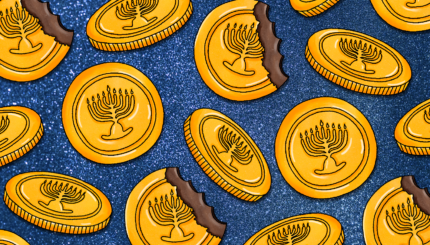Whenever I visit a new congregation, I feel a moment of anticipation before the Ark opens. I know what is contained within, in theory, but what shape will it take this time? This has become a sociological test of sorts in helping me understand the community I have entered. The poetry of any Ark speaks volumes to me.
I polled my coworkers on what they noticed about the many Arks they encounter on the road. They described wooden and marble exteriors, some painted with colorful scenes from the Torah and others plainly marked with chiseled Hebrew letters. Lit from the inside or awaiting the light spilling in from the congregation as the metal or glass or wooden doors opened, the Aron Kodesh (Holy Ark) might also feature a translucent curtain, or maybe velvet. There may be a solitary scroll, or five, adorned in crimson or silver, or wearing white dressings for the High Holidays.
In front of the Ark, the Ner Tamid, or Eternal Flame, might be encased might be encased in stained glass, offering its glow to a replication of the Ten Commandments flanked by two majestic lions of King David. Or maybe there’s a modest lantern whose bulb should have burned out years ago but continues to burn.
I find such beauty in the different homes we give the Torah. Here’s a short list of my most memorable Arks:
The author before her hometown Ark in Georgia, at her Bat Mitzvah in 2007
- My home congregation in Georgia has a simple, portable pine cabinet, handmade by congregants. It is the exact size needed to house our single Holocaust Torah which is shaded by a rich blue curtain, and the sides have handles for easy transport since we don’t have a building of our own. We have made a modest home in the Appalachian mountains, forming a semi-nomadic community as much out of intention as necessity.
- My current Mississippi congregation’s Ark opens to reveal a recessed backdrop of Jerusalem stone, up-lit with warm orange-yellow lights like the sleepy desert mountain sun, with five Torahs arranged like a choir, of varying sizes but all sporting something sparkly. Its great golden sliding doors are light enough that the children can help open the Ark. One recent Sunday, my Religious School students and I slid the doors back, and as we talked about the Five Books of Moses, one of the youngest pointed to the smallest Torah asked, “Which book is this? Exodus?”
- In Israel, many of the Orthodox synagogues I visited boasted richly-engraved cabinets of dark wood and gold paint, with molding and filigree I couldn’t properly discern from behind the mechitza. I recognized the beauty and meaning the congregants around me seemed to draw from it, even as I felt disconnected.
- At my summer camp in North Georgia, the Ark in one of the outdoor chapels is artfully carved to look like the Tree of Life reflecting on a wooden lake much like the water behind it. As we thank God for the miracles all around us, sometimes a fish or bird will respond with a splash, just beyond our focal point. It warms me to see creation moving around us as we sing our thanks and awe at its beauty.
Despite the myriad of styles I’ve seen, two things are constant: 1) We are reading the same ancient words, even if our accents tend to differ, and 2) when the Ark is open, everyone stands. No matter how we dress it up, the Torah has the power to unite us across borders and time. We wrestle, we explore, we encounter – but always, together, we rise.



